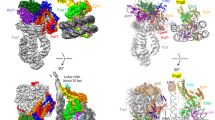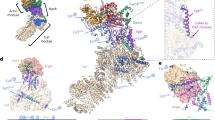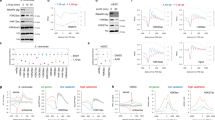Abstract
The Ada2a-containing (ATAC) complex is an essential Drosophila melanogaster histone acetyltransferase (HAT) complex that contains the transcriptional cofactors Gcn5 (KAT2), Ada3, Ada2a, Atac1 and Hcf. We have analyzed the complex by MudPIT (multidimensional protein identification technology) and found eight previously unidentified subunits. These include the WD40 repeat protein WDS, the PHD and HAT domain protein CG10414 (herein renamed Atac2/KAT14), the YEATS family member D12, the histone fold proteins CHRAC14 and NC2β, CG30390, CG32343 (Atac3) and CG10238. The presence of CG10414 (Atac2) suggests that it acts as a second acetyltransferase enzyme in ATAC in addition to Gcn5. Indeed, recombinant Atac2 displays HAT activity in vitro with a preference for acetylating histone H4, and mutation of Atac2 abrogated H4 lysine 16 acetylation in D. melanogaster embryos. Furthermore, although ATAC does not show nucleosome-remodeling activity itself, it stimulates nucleosome sliding by the ISWI, SWI–SNF and RSC complexes.
This is a preview of subscription content, access via your institution
Access options
Subscribe to this journal
Receive 12 print issues and online access
$189.00 per year
only $15.75 per issue
Buy this article
- Purchase on Springer Link
- Instant access to full article PDF
Prices may be subject to local taxes which are calculated during checkout






Similar content being viewed by others
References
de la Cruz, X., Lois, S., Sanchez-Molina, S. & Martinez-Balbas, M.A. Do protein motifs read the histone code? Bioessays 27, 164–175 (2005).
Allis, C.D. et al. New nomenclature for chromatin-modifying enzymes. Cell 131, 633–636 (2007).
Eberharter, A. & Becker, P.B. ATP-dependent nucleosome remodelling: factors and functions. J. Cell Sci. 117, 3707–3711 (2004).
Choudhary, P. & Varga-Weisz, P. ATP-dependent chromatin remodelling: action and reaction. Subcell. Biochem. 41, 29–43 (2007).
Tsukiyama, T. & Wu, C. Purification and properties of an ATP-dependent nucleosome remodeling factor. Cell 83, 1011–1020 (1995).
Ito, T., Bulger, M., Pazin, M.J., Kobayashi, R. & Kadonaga, J.T. ACF, an ISWI-containing and ATP-utilizing chromatin assembly and remodeling factor. Cell 90, 145–155 (1997).
Varga-Weisz, P.D. et al. Chromatin-remodelling factor CHRAC contains the ATPases ISWI and topoisomerase II. Nature 388, 598–602 (1997).
Lall, S. Primers on chromatin. Nat. Struct. Mol. Biol. 14, 1110–1115 (2007).
Corona, D.F. et al. Two histone fold proteins, CHRAC-14 and CHRAC-16, are developmentally regulated subunits of chromatin accessibility complex (CHRAC). EMBO J. 19, 3049–3059 (2000).
Eberharter, A. et al. Acf1, the largest subunit of CHRAC, regulates ISWI-induced nucleosome remodelling. EMBO J. 20, 3781–3788 (2001).
Hartlepp, K.F. et al. The histone fold subunits of Drosophila CHRAC facilitate nucleosome sliding through dynamic DNA interactions. Mol. Cell. Biol. 25, 9886–9896 (2005).
Kasten, M. et al. Tandem bromodomains in the chromatin remodeler RSC recognize acetylated histone H3 Lys14. EMBO J. 23, 1348–1359 (2004).
Dhalluin, C. et al. Structure and ligand of a histone acetyltransferase bromodomain. Nature 399, 491–496 (1999).
Hassan, A.H., Neely, K.E. & Workman, J.L. Histone acetyltransferase complexes stabilize SWI–SNF binding to promoter nucleosomes. Cell 104, 817–827 (2001).
Chandy, M., Gutierrez, J.L., Prochasson, P. & Workman, J.L. SWI/SNF displaces SAGA-acetylated nucleosomes. Eukaryot. Cell 5, 1738–1747 (2006).
Carey, M., Li, B. & Workman, J.L. RSC exploits histone acetylation to abrogate the nucleosomal block to RNA polymerase II elongation. Mol. Cell 24, 481–487 (2006).
Hassan, A.H., Awad, S. & Prochasson, P. The Swi2/Snf2 bromodomain is required for the displacement of SAGA and the octamer transfer of SAGA-acetylated nucleosomes. J. Biol. Chem. 281, 18126–18134 (2006).
Lee, K.K. & Workman, J.L. Histone acetyltransferase complexes: one size doesn't fit all. Nat. Rev. Mol. Cell Biol. 8, 284–295 (2007).
Kimura, A., Matsubara, K. & Horikoshi, M. A decade of histone acetylation: marking eukaryotic chromosomes with specific codes. J. Biochem. 138, 647–662 (2005).
Carrozza, M.J., Utley, R.T., Workman, J.L. & Cote, J. The diverse functions of histone acetyltransferase complexes. Trends Genet. 19, 321–329 (2003).
Timmers, H.T. & Tora, L. SAGA unveiled. Trends Biochem. Sci. 30, 7–10 (2005).
Daniel, J.A. & Grant, P.A. Multi-tasking on chromatin with the SAGA coactivator complexes. Mutat. Res. 618, 135–148 (2007).
Sterner, D.E. et al. Functional organization of the yeast SAGA complex: distinct components involved in structural integrity, nucleosome acetylation, and TATA-binding protein interaction. Mol. Cell. Biol. 19, 86–98 (1999).
Balasubramanian, R., Pray-Grant, M.G., Selleck, W., Grant, P.A. & Tan, S. Role of the Ada2 and Ada3 transcriptional coactivators in histone acetylation. J. Biol. Chem. 277, 7989–7995 (2002).
Kusch, T., Guelman, S., Abmayr, S.M. & Workman, J.L. Two Drosophila Ada2 homologues function in different multiprotein complexes. Mol. Cell. Biol. 23, 3305–3319 (2003).
Muratoglu, S. et al. Two different Drosophila ADA2 homologues are present in distinct GCN5 histone acetyltransferase-containing complexes. Mol. Cell. Biol. 23, 306–321 (2003).
Barlev, N.A. et al. A novel human Ada2 homologue functions with Gcn5 or Brg1 to coactivate transcription. Mol. Cell. Biol. 23, 6944–6957 (2003).
Guelman, S. et al. Host cell factor and an uncharacterized SANT domain protein are stable components of ATAC, a novel dAda2A/dGcn5-containing histone acetyltransferase complex in Drosophila. Mol. Cell. Biol. 26, 871–882 (2006).
Goppelt, A. & Meisterernst, M. Characterization of the basal inhibitor of class II transcription NC2 from Saccharomyces cerevisiae. Nucleic Acids Res. 24, 4450–4455 (1996).
Hollmann, M., Simmerl, E., Schafer, U. & Schafer, M.A. The essential Drosophila melanogaster gene wds (will die slowly) codes for a WD-repeat protein with seven repeats. Mol. Genet. Genomics 268, 425–433 (2002).
Mendjan, S. et al. Nuclear pore components are involved in the transcriptional regulation of dosage compensation in Drosophila. Mol. Cell 21, 811–823 (2006).
Carre, C., Szymczak, D., Pidoux, J. & Antoniewski, C. The histone H3 acetylase dGcn5 is a key player in Drosophila melanogaster metamorphosis. Mol. Cell. Biol. 25, 8228–8238 (2005).
Yokoyama, A. et al. Leukemia proto-oncoprotein MLL forms a SET1-like histone methyltransferase complex with menin to regulate Hox gene expression. Mol. Cell. Biol. 24, 5639–5649 (2004).
Grant, P.A., Berger, S.L. & Workman, J.L. Identification and analysis of native nucleosomal histone acetyltransferase complexes. Methods Mol. Biol. 119, 311–317 (1999).
Kuo, M.H. et al. Transcription-linked acetylation by Gcn5p of histones H3 and H4 at specific lysines. Nature 383, 269–272 (1996).
Ciurciu, A., Komonyi, O., Pankotai, T. & Boros, I.M. The Drosophila histone acetyltransferase Gcn5 and transcriptional adaptor Ada2a are involved in nucleosomal histone H4 acetylation. Mol. Cell. Biol. 26, 9413–9423 (2006).
Hilfiker, A., Hilfiker-Kleiner, D., Pannuti, A. & Lucchesi, J.C. mof, a putative acetyl transferase gene related to the Tip60 and MOZ human genes and to the SAS genes of yeast, is required for dosage compensation in Drosophila. EMBO J. 16, 2054–2060 (1997).
Kamada, K. et al. Crystal structure of negative cofactor 2 recognizing the TBP-DNA transcription complex. Cell 106, 71–81 (2001).
Aasland, R., Stewart, A.F. & Gibson, T. The SANT domain: a putative DNA-binding domain in the SWI-SNF and ADA complexes, the transcriptional co-repressor N-CoR and TFIIIB. Trends Biochem. Sci. 21, 87–88 (1996).
Kukimoto, I., Elderkin, S., Grimaldi, M., Oelgeschlager, T. & Varga-Weisz, P.D. The histone-fold protein complex CHRAC-15/17 enhances nucleosome sliding and assembly mediated by ACF. Mol. Cell 13, 265–277 (2004).
Vary, J.C., Jr et al. Yeast Isw1p forms two separable complexes in vivo. Mol. Cell. Biol. 23, 80–91 (2003).
Stockdale, C., Flaus, A., Ferreira, H. & Owen-Hughes, T. Analysis of nucleosome repositioning by yeast ISWI and Chd1 chromatin remodeling complexes. J. Biol. Chem. 281, 16279–16288 (2006).
Yang, J.G., Madrid, T.S., Sevastopoulos, E. & Narlikar, G.J. The chromatin-remodeling enzyme ACF is an ATP-dependent DNA length sensor that regulates nucleosome spacing. Nat. Struct. Mol. Biol. 13, 1078–1083 (2006).
Mohrmann, L. et al. Differential targeting of two distinct SWI/SNF-related Drosophila chromatin-remodeling complexes. Mol. Cell. Biol. 24, 3077–3088 (2004).
Katsani, K.R., Mahmoudi, T. & Verrijzer, C.P. Selective gene regulation by SWI/SNF-related chromatin remodeling factors. Curr. Top. Microbiol. Immunol. 274, 113–141 (2003).
Jacobson, R.H., Ladurner, A.G., King, D.S. & Tjian, R. Structure and function of a human TAFII250 double bromodomain module. Science 288, 1422–1425 (2000).
Hassan, A.H. et al. Function and selectivity of bromodomains in anchoring chromatin-modifying complexes to promoter nucleosomes. Cell 111, 369–379 (2002).
Ferreira, R. et al. Site-specific acetylation of ISWI by GCN5. BMC Mol. Biol. 8, 73 (2007).
Rudolph, M.J., Wuebbens, M.M., Turque, O., Rajagopalan, K.V. & Schindelin, H. Structural studies of molybdopterin synthase provide insights into its catalytic mechanism. J. Biol. Chem. 278, 14514–14522 (2003).
Corona, D.F., Clapier, C.R., Becker, P.B. & Tamkun, J.W. Modulation of ISWI function by site-specific histone acetylation. EMBO Rep. 3, 242–247 (2002).
Shogren-Knaak, M. et al. Histone H4–K16 acetylation controls chromatin structure and protein interactions. Science 311, 844–847 (2006).
Suganuma, T., Kawabata, M., Ohshima, T. & Ikeda, M.A. Growth suppression of human carcinoma cells by reintroduction of the p300 coactivator. Proc. Natl. Acad. Sci. USA 99, 13073–13078 (2002).
Rigaut, G. et al. A generic protein purification method for protein complex characterization and proteome exploration. Nat. Biotechnol. 17, 1030–1032 (1999).
Lee, K.K., Florens, L., Swanson, S.K., Washburn, M.P. & Workman, J.L. The deubiquitylation activity of Ubp8 is dependent upon Sgf11 and its association with the SAGA complex. Mol. Cell. Biol. 25, 1173–1182 (2005).
Eberharter, A., John, S., Grant, P.A., Utley, R.T. & Workman, J.L. Identification and analysis of yeast nucleosomal histone acetyltransferase complexes. Methods 15, 315–321 (1998).
Thastrom, A., Bingham, L.M. & Widom, J. Nucleosomal locations of dominant DNA sequence motifs for histone-DNA interactions and nucleosome positioning. J. Mol. Biol. 338, 695–709 (2004).
Gutierrez, J. et al. Interaction of CBFα/AML/PEBP2α transcription factors with nucleosomes containing promoter sequences requires flexibility in the translational positioning of the histone octamer and exposure of the CBFα site. Biochemistry 39, 13565–13574 (2000).
Utley, R.T. et al. In vitro analysis of transcription factor binding to nucleosomes and nucleosome disruption/displacement. Methods Enzymol. 274, 276–291 (1996).
Gutierrez, J.L., Chandy, M., Carrozza, M.J. & Workman, J.L. Activation domains drive nucleosome eviction by SWI/SNF. EMBO J. 26, 730–740 (2007).
Tomomori-Sato, C. et al. A mammalian mediator subunit that shares properties with Saccharomyces cerevisiae mediator subunit Cse2. J. Biol. Chem. 279, 5846–5851 (2004).
Keller, C.A., Grill, M.A. & Abmayr, S.M. A role for nautilus in the differentiation of muscle precursors. Dev. Biol. 202, 157–171 (1998).
Acknowledgements
We thank R. Mantovani and M. Hammel for advice on protein structures, K. Wagner for technical assistance, and C. Tomomori-Sato and S. Sato for advice on Flag purification. This research was supported by the Howard Hughes Medical Institute and the Stowers Institute for Medical Research.
Author information
Authors and Affiliations
Corresponding author
Supplementary information
Supplementary Text and Figures
Supplementary figures 1–5, Supplementary Table 1 and Supplementary Methods (PDF 12171 kb)
Rights and permissions
About this article
Cite this article
Suganuma, T., Gutiérrez, J., Li, B. et al. ATAC is a double histone acetyltransferase complex that stimulates nucleosome sliding. Nat Struct Mol Biol 15, 364–372 (2008). https://doi.org/10.1038/nsmb.1397
Received:
Accepted:
Published:
Issue Date:
DOI: https://doi.org/10.1038/nsmb.1397
This article is cited by
-
Unveiling the role of GAS41 in cancer progression
Cancer Cell International (2023)
-
Histone acetyltransferase CSRP2BP promotes the epithelial–mesenchymal transition and metastasis of cervical cancer cells by activating N-cadherin
Journal of Experimental & Clinical Cancer Research (2023)
-
Conserved and plant-specific histone acetyltransferase complexes cooperate to regulate gene transcription and plant development
Nature Plants (2023)
-
Multifaceted roles of YEATS domain-containing proteins and novel links to neurological diseases
Cellular and Molecular Life Sciences (2022)
-
MBIP (MAP3K12 binding inhibitory protein) drives NSCLC metastasis by JNK-dependent activation of MMPs
Oncogene (2020)



